Page 486 of 590
486
5-2. Steps to take in an emergency
If you have a flat tire
Your vehicle is equipped with a spare tire. The flat tire can be
replaced with the spare tire.
■Before jacking up the vehicle
●Stop the vehicle on a hard, flat surface.
● Set the parking brake.
● Shift the shift lever to P (automatic transmission) or R (manual
transmission).
● Stop the engine.
● Turn on the emergency flashers.
■ Location of the spare tire
■ Location of the jack and tools
Access Cab models
Tool bag
Jack
Page 502 of 590
502
5-2. Steps to take in an emergency
If the shift lever cannot be shifted from P (vehicles with an automatic transmission)
If the shift lever cannot be shifted with your foot on the brake, there
may be a problem with the shift lock system (a system to prevent
accidental operation of the shift lever). Have the vehicle inspected by
your Toyota dealer immediately.
The following steps may be used as an emergency measure to
ensure that the shift lever can be shifted.
Set the parking brake.
Turn the engine switch to the ACC or ON position.
Depress the brake pedal.
Pry the cover up with a flat-
head screwdriver or equiva-
lent.
Press the shift lock override
button.
The shift lever can be shifted
while the button is pressed.
Page 506 of 590
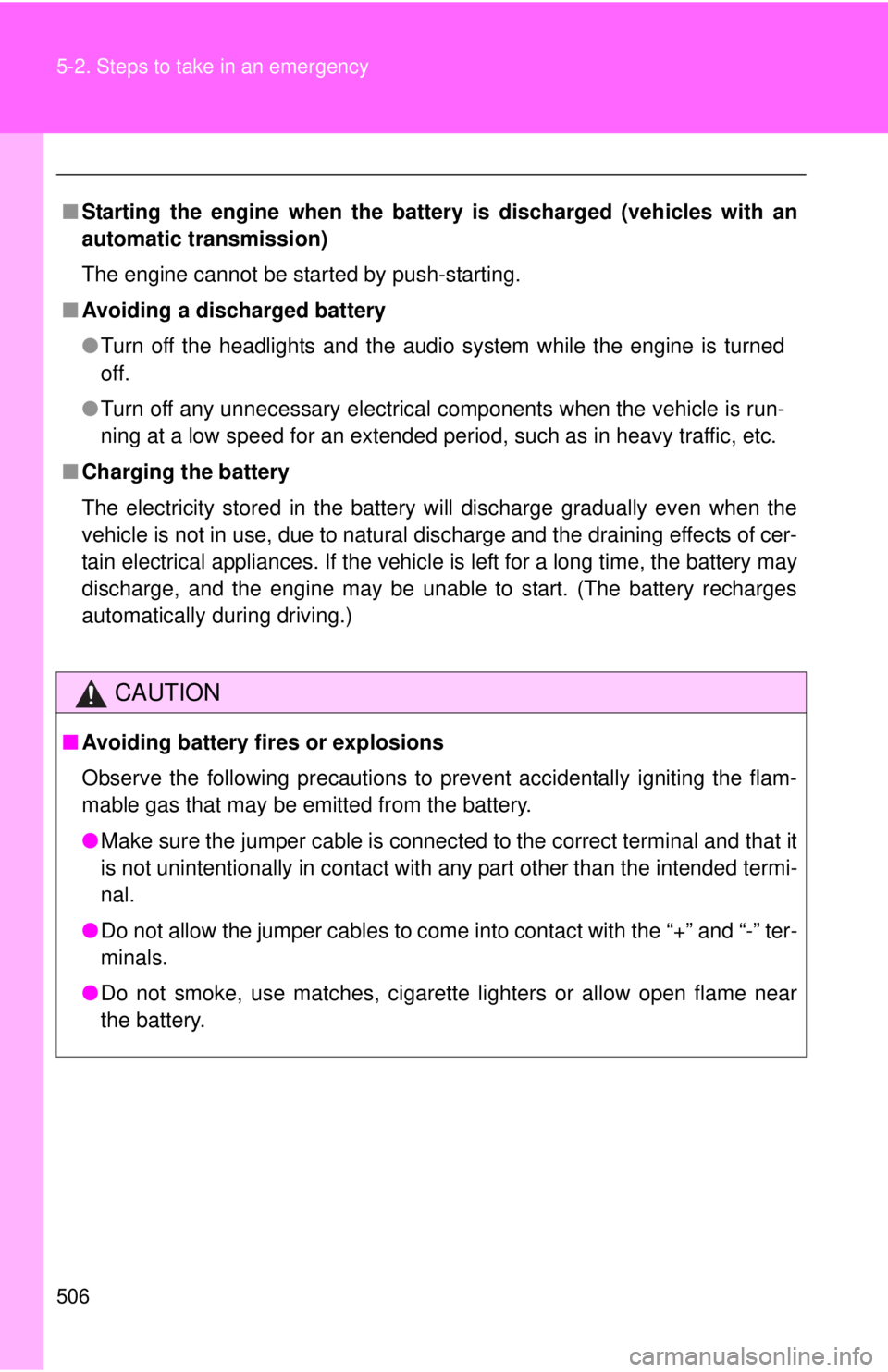
506 5-2. Steps to take in an emergency
■Starting the engine when the battery is discharged (vehicles with an
automatic transmission)
The engine cannot be started by push-starting.
■ Avoiding a discharged battery
●Turn off the headlights and the audio system while the engine is turned
off.
● Turn off any unnecessary electrical components when the vehicle is run-
ning at a low speed for an extended period, such as in heavy traffic, etc.
■ Charging the battery
The electricity stored in the battery will discharge gradually even when the
vehicle is not in use, due to natural discharge and the draining effects of cer-
tain electrical appliances. If the vehicle is left for a long time, the battery may
discharge, and the engine may be unable to start. (The battery recharges
automatically during driving.)
CAUTION
■Avoiding battery fires or explosions
Observe the following precautions to prevent accidentally igniting the flam-
mable gas that may be emitted from the battery.
●Make sure the jumper cable is connected to the correct terminal and that it
is not unintentionally in contact with any part other than the intended termi-
nal.
● Do not allow the jumper cables to come into contact with the “+” and “-” ter-
minals.
● Do not smoke, use matches, cigarette lighters or allow open flame near
the battery.
Page 507 of 590
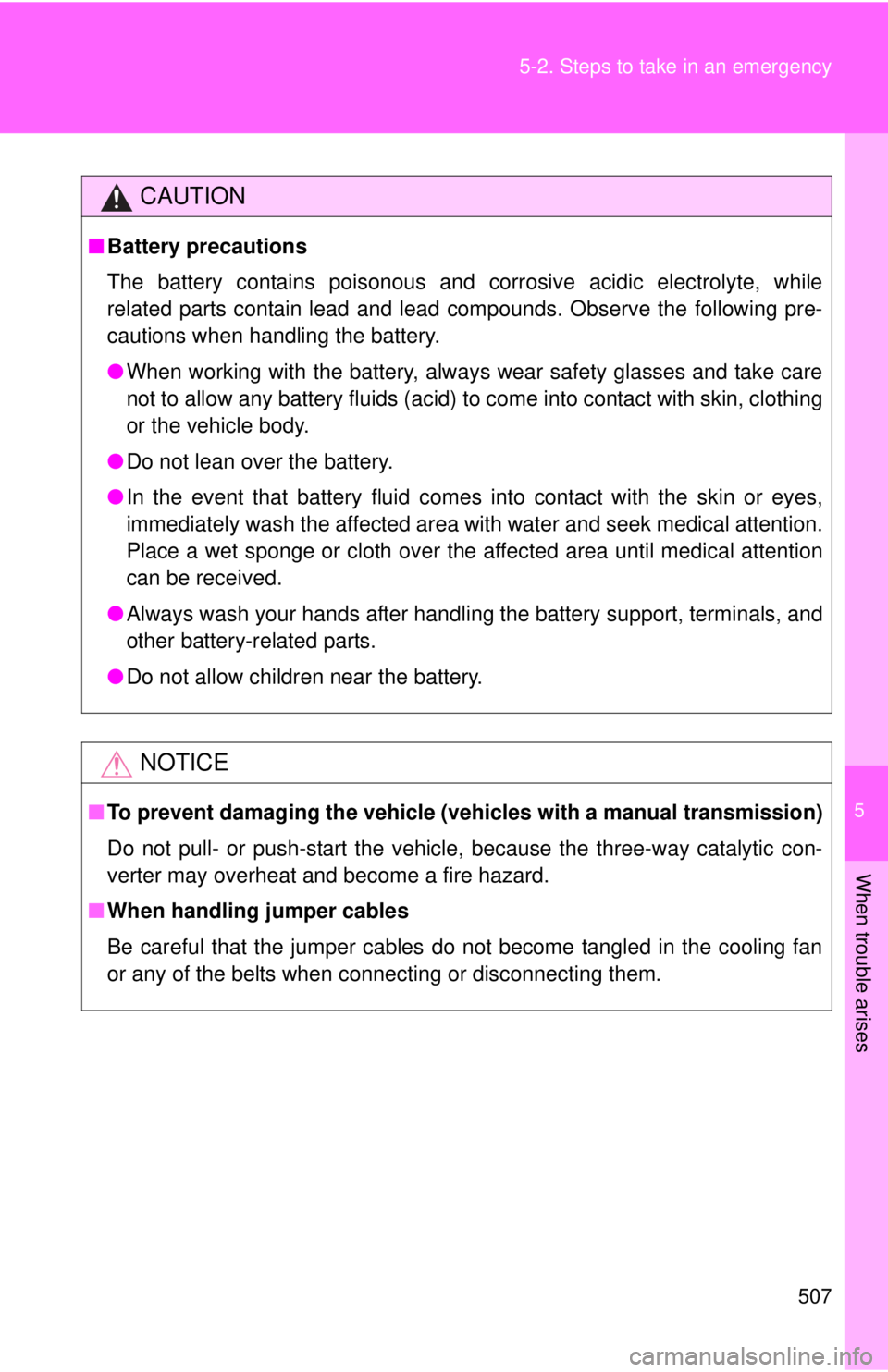
5
When trouble arises
507
5-2. Steps to take in an emergency
CAUTION
■
Battery precautions
The battery contains poisonous and corrosive acidic electrolyte, while
related parts contain lead and lead compounds. Observe the following pre-
cautions when handling the battery.
●When working with the battery, always wear safety glasses and take care
not to allow any battery fluids (acid) to come into contact with skin, clothing
or the vehicle body.
● Do not lean over the battery.
● In the event that battery fluid comes into contact with the skin or eyes,
immediately wash the affected area with water and seek medical attention.
Place a wet sponge or cloth over the affected area until medical attention
can be received.
● Always wash your hands after handling the battery support, terminals, and
other battery-related parts.
● Do not allow children near the battery.
NOTICE
■To prevent damaging the vehicle (vehicles with a manual transmission)
Do not pull- or push-start the vehicle, because the three-way catalytic con-
verter may overheat and become a fire hazard.
■ When handling jumper cables
Be careful that the jumper cables do not become tangled in the cooling fan
or any of the belts when connecting or disconnecting them.
Page 511 of 590
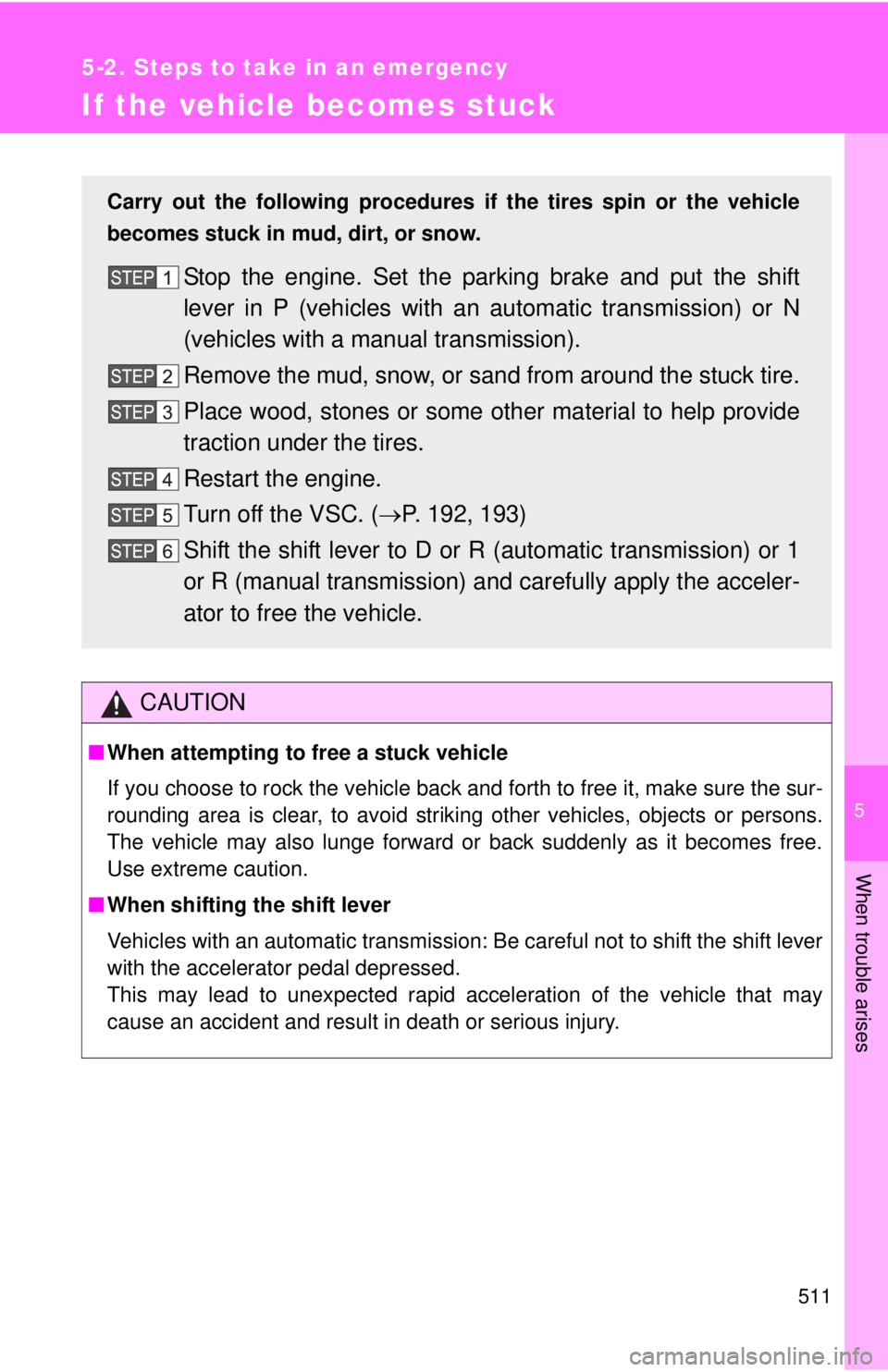
5
When trouble arises
511
5-2. Steps to take in an emergency
If the vehicle becomes stuck
CAUTION
■When attempting to free a stuck vehicle
If you choose to rock the vehicle back and forth to free it, make sure the sur-
rounding area is clear, to avoid striking other vehicles, objects or persons.
The vehicle may also lunge forward or back suddenly as it becomes free.
Use extreme caution.
■ When shifting the shift lever
Vehicles with an automatic transmission: Be careful not to shift the shift lever
with the accelerator pedal depressed.
This may lead to unexpected rapid acceleration of the vehicle that may
cause an accident and result in death or serious injury.
Carry out the following procedures if the tires spin or the vehicle
becomes stuck in mud, dirt, or snow.
Stop the engine. Set the parking brake and put the shift
lever in P (vehicles with an automatic transmission) or N
(vehicles with a manual transmission).
Remove the mud, snow, or sand from around the stuck tire.
Place wood, stones or some other material to help provide
traction under the tires.
Restart the engine.
Turn off the VSC. ( P. 192, 193)
Shift the shift lever to D or R (automatic transmission) or 1
or R (manual transmission) and carefully apply the acceler-
ator to free the vehicle.
Page 512 of 590
512 5-2. Steps to take in an emergency
NOTICE
■To avoid damaging the transmission and other components
●Avoid spinning the wheels and do not rev up the engine.
● If the vehicle remains stuck after trying these procedures, the vehicle may
require towing to be freed.
Page 529 of 590
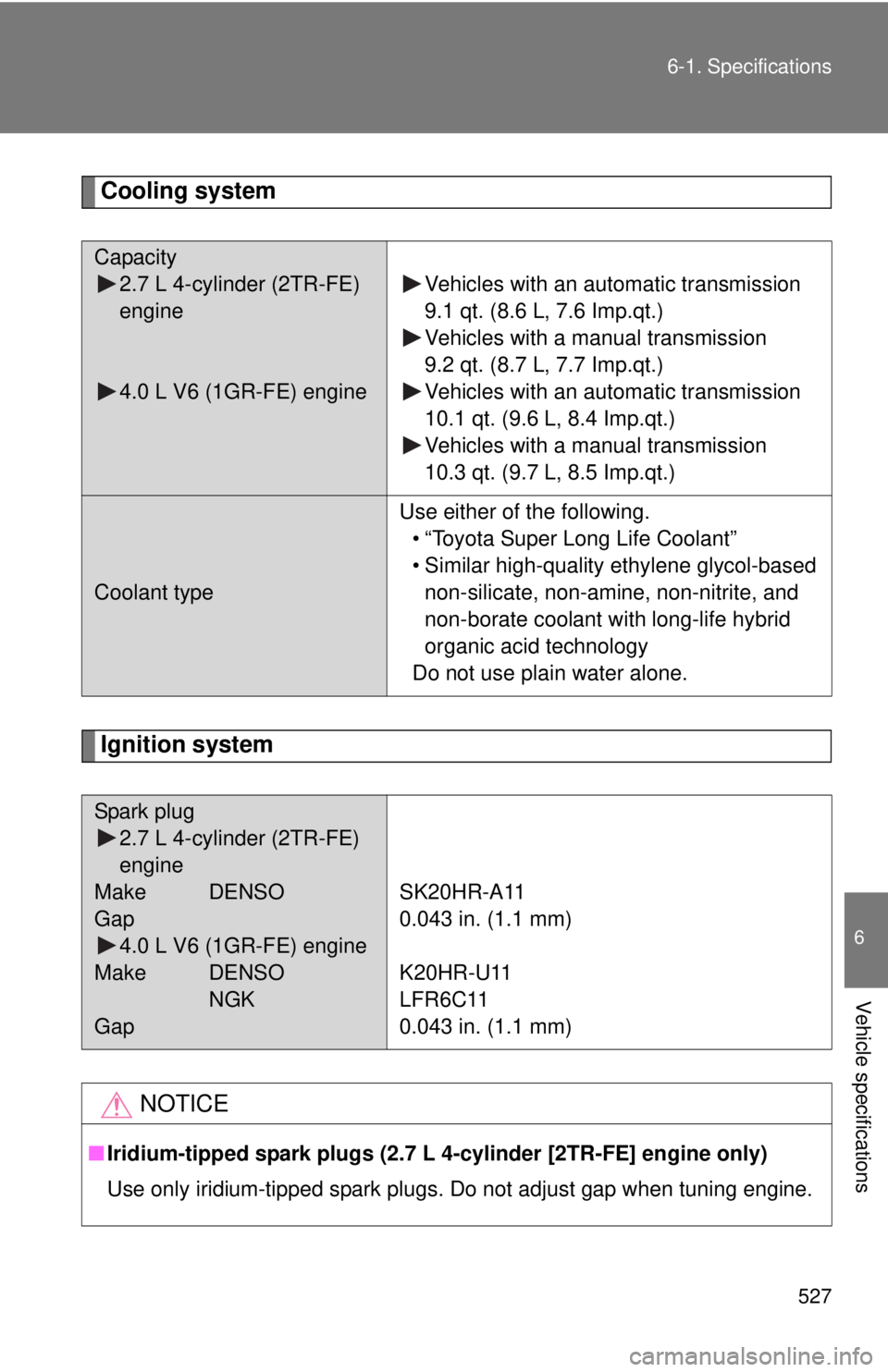
527
6-1. Specifications
6
Vehicle specifications
Cooling system
Ignition system
Capacity
2.7 L 4-cylinder (2TR-FE)
engine
4.0 L V6 (1GR-FE) engine Vehicles with an automatic transmission
9.1 qt. (8.6 L, 7.6 Imp.qt.)
Vehicles with a manual transmission
9.2 qt. (8.7 L, 7.7 Imp.qt.)
Vehicles with an automatic transmission
10.1 qt. (9.6 L, 8.4 Imp.qt.)
Vehicles with a manual transmission
10.3 qt. (9.7 L, 8.5 Imp.qt.)
Coolant type
Use either of the following.
• “Toyota Super Long Life Coolant”
• Similar high-quality ethylene glycol-based non-silicate, non-amine, non-nitrite, and
non-borate coolant with long-life hybrid
organic acid technology
Do not use plain water alone.
Spark plug 2.7 L 4-cylinder (2TR-FE)
engine
Make DENSO
Gap 4.0 L V6 (1GR-FE) engine
Make DENSO NGK
Gap SK20HR-A11
0.043 in. (1.1 mm)
K20HR-U11
LFR6C11
0.043 in. (1.1 mm)
NOTICE
■
Iridium-tipped spark plugs (2.7 L 4-cylinder [2TR-FE] engine only)
Use only iridium-tipped spark plugs. Do not adjust gap when tuning engine.
Page 531 of 590
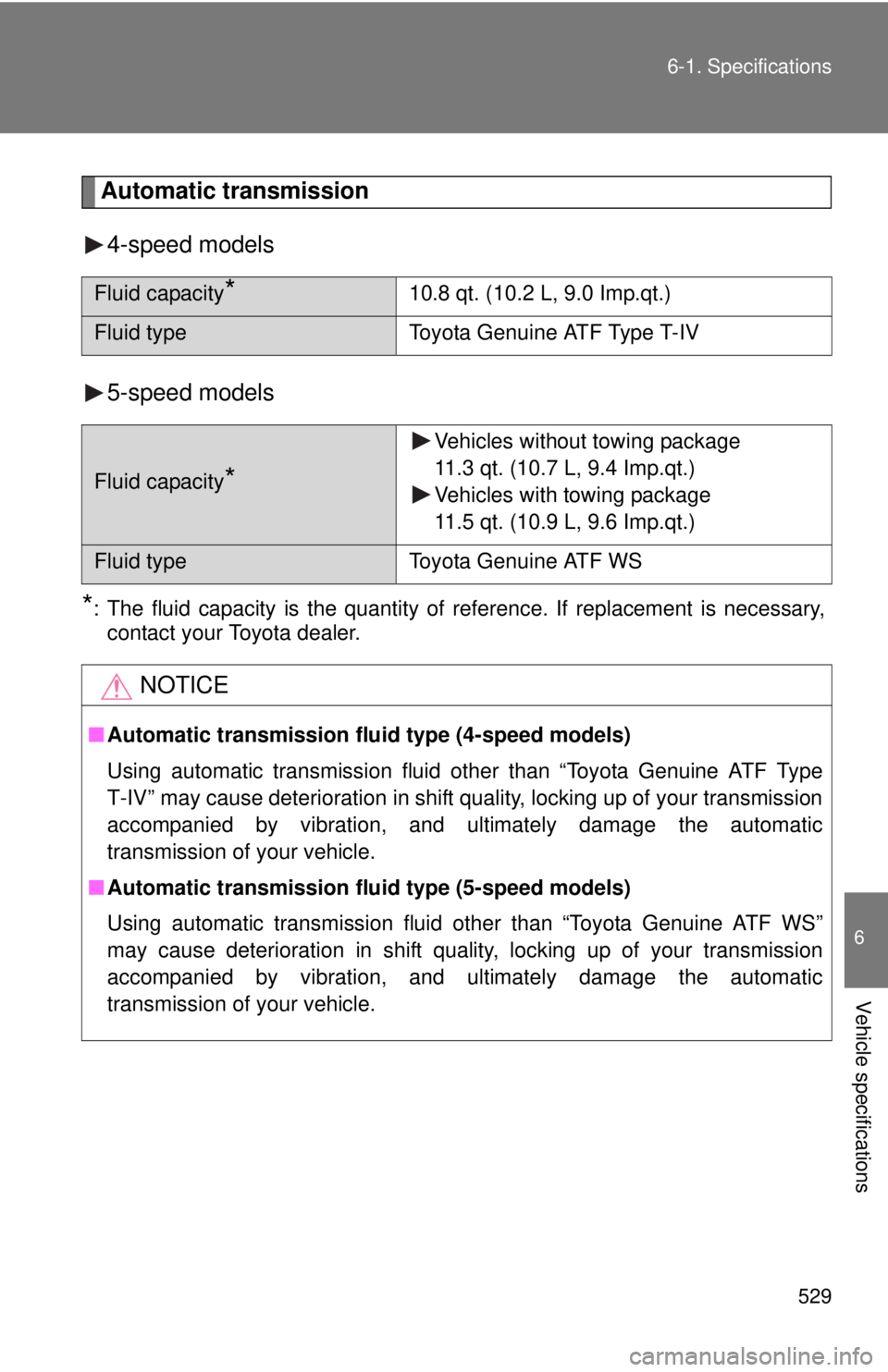
529
6-1. Specifications
6
Vehicle specifications
Automatic transmission
4-speed models
5-speed models
*: The fluid capacity is the quantity of reference. If replacement is necessary, contact your Toyota dealer.
Fluid capacity*10.8 qt. (10.2 L, 9.0 Imp.qt.)
Fluid type Toyota Genuine ATF Type T-IV
Fluid capacity*
Vehicles without towing package
11.3 qt. (10.7 L, 9.4 Imp.qt.)
Vehicles with towing package
11.5 qt. (10.9 L, 9.6 Imp.qt.)
Fluid type Toyota Genuine ATF WS
NOTICE
■Automatic transmission fluid type (4-speed models)
Using automatic transmission fluid other than “Toyota Genuine ATF Type
T-IV” may cause deterioration in shift quality, locking up of your transmission
accompanied by vibration, and ultimately damage the automatic
transmission of your vehicle.
■ Automatic transmission fluid type (5-speed models)
Using automatic transmission fluid other than “Toyota Genuine ATF WS”
may cause deterioration in shift quality, locking up of your transmission
accompanied by vibration, and ultimately damage the automatic
transmission of your vehicle.